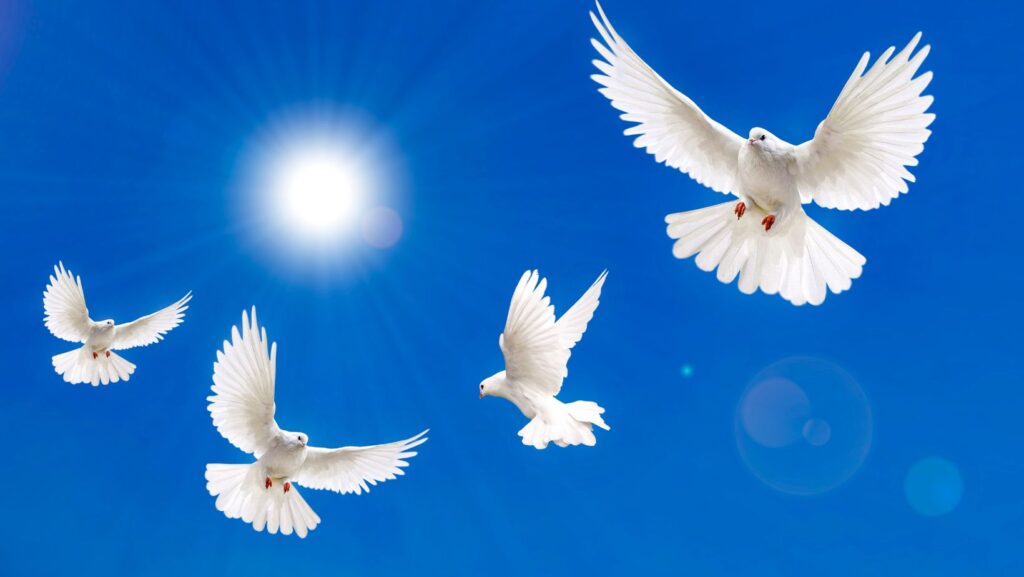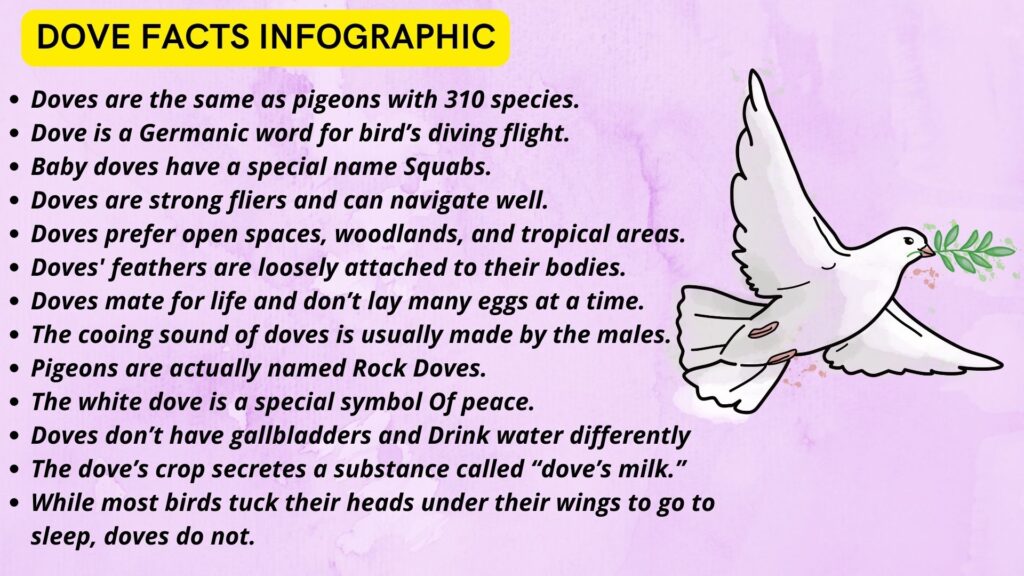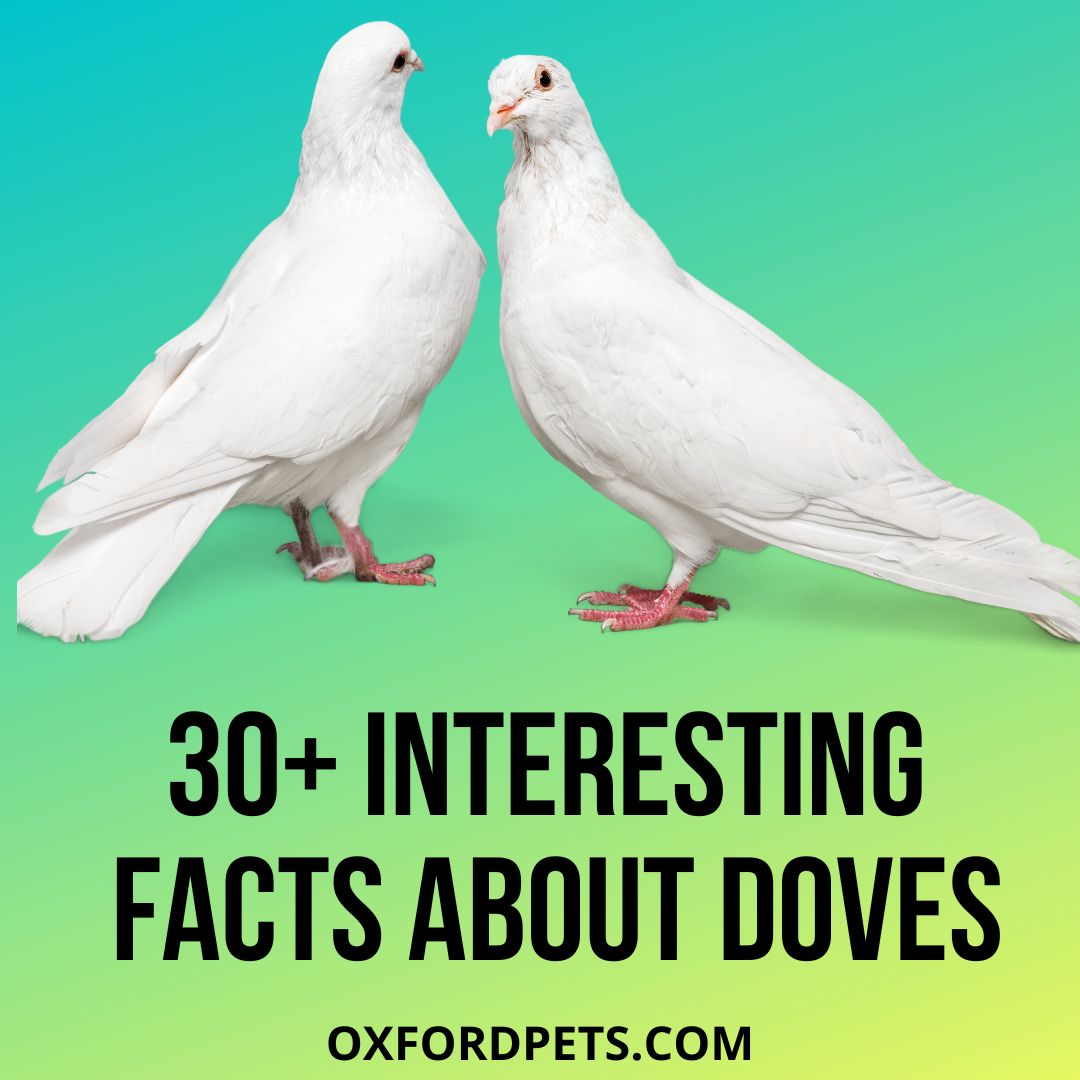Around the world, the dove is a symbol of peace. It’s hard to decide exactly when the dove became a peace symbol. We do realize that people commenced domesticating pigeons before the time of written language, probably 10,000 years ago. So, for hundreds of years, pigeons and doves have been used as a food supply and to send messages. here we will discuss some facts about doves.
Contents
Amazing dove facts
- There are 310 species of doves.
- Doves come from the Columbidae family.
- Doves are the most common birds in the world.
- They are everywhere on the earth, except in the driest areas.
- These birds live in almost every type of terrestrial habitat.
- Doves live for a longer period of time.
- They live for around 10-12 years.
- You can call a dove “pigeon” as well.
- Dove is a Germanic word for bird’s diving flight.
- The larger species of doves are called pigeons.
- Doves and pigeons vary in size(ranging from 15-75 cm in length and 22g-2000g in weight)
- These are stout-bodied birds with slender bills and short necks.
- Their wings are large.
- The wings have 11 primary feathers and strong wing muscles.
- Also, they are among the strongest fliers.
- The seed-eating species of doves are grey, brown, and buff.
- The fruit-eater doves are bright in color.
- The doves have iridescent feathers and ornamentation on the breast, neck, face, and wings.
- They range from sexually monomorphic to sexually dimorphic.
- Doves can be very social and solitary.
- Some are migratory and others are sedentary.
- Some species are nomadic and others make altitudinal movements as the season changes.
Facts About Dove food habits
- Fruits and seeds are a major part of their diets.
- The seed-eating doves are known as granivorous species.
- The fruit-eating doves are called frugivorous species.
- Some species also eat snails, insects, lizards, buds, flowers, leaves, and worms.
- To digest seeds, granivorous doves drink a lot of water.
- The desert species of doves get their water from succulent plants.
Some More Dove facts You must Know
- Some dove species are lifelong mates, but some mate only for a breeding season.
- Doves are good navigators and use the position of the sun and magnetic field to find their way.
- However, doves are monogamous.
- Some doves have different calls and songs. They use this to find mates, defend territories, and signal danger.
- Some dove species breed colonially and some solitarily.
- The photoperiod and food availability trigger the breeding. Also, this can be year-round or seasonal.
- The incubation lasts for 11-30 days.
- The clutch size is 1-2 eggs.
- Both females and males incubate, but females spend more time during incubation.
- The male and female doves produce crop milk to feed the young ones.
- The dove and an olive branch are symbols of peace for Christians.
- This also symbolizes the act of baptism.
- In Christian Iconography, a dove symbolizes the Holy Spirit.

21 Fascinating facts about mourning doves
- Mourning doves do not sweat. Hence, to stay cool in summers, they pant like a canine.
- Doves drink a lot of water so that they can pant during the hot weather.
- They produce a mournful sound that is mostly responsible for their common name.
- Mourning doves suck water rather than taking a bill and trickling it down their throat.
- They suck the daily requirement of water within 20 seconds.
- The females wove the nests with the materials that males bring.
- The male dove supervises the construction of the nest by standing behind the working female.
- They usually have 6 clutches per year with a clutch size of 2.
- Doves are the most widespread game birds in North America.
- Still. They are one of the most abundant birds in the US with a fall population of 400 million birds.
- Around 50-65% of mourning doves die annually.
- They have an average lifespan of about 1 and half years.
- The oldest one lived for over 31 years.
- Both the genders look very similar. However, the male mourning doves are a bit larger than the females.
- Also, they have more colorful crowns on their heads.
- Both the genders can feed the young ones. This crop milk is a yogurt-like secretion produced by the walls of the crop.
- Mourning birds can fly at a speed of 40-55 mph.
- Their diets are mostly seeds that they find on the ground.
- These doves are monogamous for the entire breeding season.
- They may also re-pair in succeeding breeding seasons.
- Their feathers are loosely attached to their skin.

What does a dove symbolize?
- Love
- Devotion
- Peace
- Navigation
- Grace
- Messages
- Purity
- Gentleness
- Hope
- The Holy Spirit
- The Human Soul
Dove Spirit Animal
When the dove is your spirit animal, you have been blessed with a mild guide who assists you as you navigate your life direction here on Earth.
You may also already know that the dove is your spirit animal, or one may also have abruptly crossed your direction and made themselves known to you. Seeing a dove or maybe a couple of doves is always a wonderful omen.
Are doves very smart?
Yes, doves are very smart. In fact, One awesome characteristic of a dove that is very incredible is its ability to learn and to quickly adapt to new matters and its surroundings in order to continue to exist.
This and plenty of different features make the dove a completely clever and sensible bird.
They might not be as clever as parrots, however, additionally, they rank fairly high when you evaluate them to other birds.
However, maximum humans will assume that doves are dumb birds, especially mourning doves.
Mourning doves, you may have observed they may take time to leave the street you are driving on as they almost hop on the street as if they need you to kill them.
With this kind of movement and experience, humans will frequently just conclude that a dove is simply dumb. However, this is a long way from the truth.
The mind of a dove is capable of processing pictures at a much better rate than we humans.
And so, we can’t use the incapability of a dove to perceive risk quickly to now then use this as a parameter to conclude how clever or dumb a dove is.
It is excellent to check and observe the intelligence of a dove by simply how much they adapt, respond, and continue to exist in their surroundings.
What can we learn from doves?
Be confident.
Doves discover ways to trust themselves before they take off inside the sky. So believe in your capabilities and realize that you’ll discover a warm current to jump in.
Let your shades shine.
Different birds have loads of various hues. Be vibrant and ensure you are not hiding what makes you one-of-a-kind.
Show up early and often.
The mythical early chook receives the bug for a reason. To locate something really well worth displaying up for, after which display up each day.
Go with the seasons.
Doves thrive in spite of changes in their environment. Be fluid and go along with the flow, trusting your ability to always discover a branch to land on.
Flock together.
Doves seek energy and sustenance from one another. Keep pals and family nearby as you navigate the days.
Spread your wings.
Eventually, all birds must leave the protection of the nest and end up what they’re supposed to be. Have no worry about falling, and begin flapping.
- Can You Own A Flamingo As a pet? Is It Legal?
- How To Deworm Chicken? 10 Easy Ways
- 6 Chicken Breeds Having Black Meat, Skin, and Bones
Final words
I hope you enjoyed the article on “facts about doves”. Along with it, we have also talked about some amazing things related to doves.
We will be back soon with more informative and interesting articles. Till then, stay connected. Thank you.
Frequently asked questions
How long do doves live?
The common life span for a grownup Dove is 1.5 years. The oldest recognized free-residing bird, discovered via bird banding research, was over 31 years old. This is the record lifespan for a North American bird that lives.
What do doves stand for?
Doves, commonly white in color, are used in lots of settings as symbols of freedom, peace, love, or as messengers. Doves seem withinside the symbolism of Christianity, Islam, Judaism, and Paganism, and of both army and pacifist groups.
How fast can doves fly?
55 mph: Their lengthy, pointed wings are almost falcon-like in appearance, while their pointed tails are longer than the ones of any other birds. These “design features” allow the birds to fly fast.
What is unique about doves?
Doves are brilliant animals. Their potential to find their way home over hundreds, even thousands of kilometers is unrivaled in the animal kingdom. This uncanny capacity has seen them used for hundreds of years to deliver messages to royalty, army leaders, and different super figures.
